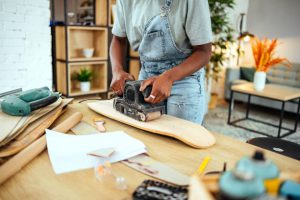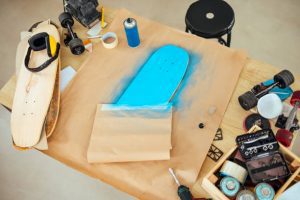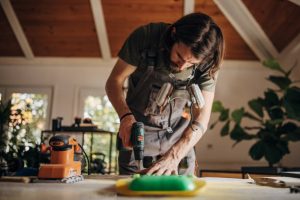Ready to build your longboard?
We’ve all felt that rush of freedom, gliding down the pavement on a handmade board, the wind whipping past.
We know how addictive it can be – that sense of balance and control.

And if you’re anything like us, you’ve also fantasized about making your custom board.
But where to start?
Building a DIY longboard skateboard can be a great project, and you don’t have to work alone; YouTube provides a full array of tutorials that can give you step-by-step guidance. These resources are perfect for beginners looking to add a personal touch to their ride. The process is surprisingly simple; you can find all the necessary materials online. When assembling, ensure every screw is tightened securely—a bit of attention to detail here can make a big difference in the performance of your finished board.
Don’t worry. FamilyHype is here to guide you step-by-step through this exciting DIY project.
We believe that with some patience, simple tools, and a bit of guidance, even beginners can build their personalized design boards.
This article is your step-by-step guide to understanding the basics of longboards and longboard riding basics, choosing materials, and designing and constructing your own skateboard deck. Ready to feel that fun and thrill again? Let’s get started!
If you take on this new project, we would love to hear your experience and opinions along the way. Please feel free to share your thoughts with us. We know that it is a great way to have fun and stay active, and we hope this guide will inspire you to create your custom skateboard projects.
Understand The Basics Of Longboard
If you’re ready to take your building skills to the next level, let’s get the basics down pat – it’s not as complicated as it seems!
Longboarding involves riding a longer and wider skateboard, a longboard designed for cruising, carving, and downhill riding. Its stable deck and larger, softer wheels make it beginner-friendly, providing a smooth ride. The longboarding community embraces various disciplines like freestyle and dancing. Riders often customize their setups for a personalized experience, exploring the diverse aspects of this dynamic sport.
Understanding the history and different styles is key to crafting your skateboard or longboard deck. From downhill racing to freestyle dancing, each style has a lot of unique characteristics that will serve others with varied interests.
Choose Your Materials
Now that we’ve got our balance in check, it’s time to dive into the nitty-gritty of building our board—awesome stuff for enthusiasts looking to create their unique setups.
Choosing the appropriate materials can make or break our do-it-yourself project, and you have to learn how to pick the right wood for the deck, which is paramount. Just as considering which trucks and wheels best fit our riding style is essential.
Selecting the right materials for a skateboard deck encompasses a range of considerations, starting with the deck shape that suits your riding style. After affixing grip tape, excess grip tape can be expertly cut using a razor blade. This ensures that the grip tape has a clean and secure fit.
Choosing between leaving the natural wood finish or applying a personal touch with spray paint or leftover paint provides creative freedom. Follow this by carving and sanding the edges and smoothing any imperfections to ensure a comfortable grip.
Drilling holes and carefully placing screws allow components like the truck’s wheels to be securely attached. Whether opting for a paper cover or letting the grip tape stick, a well-thought-out material selection guarantees a visually appealing board and a reliable and enjoyable ride.
We might have some trial and error along the way, but remember, every great rider was once where we are now.
The Right Wood
Choosing the perfect wood for your board isn’t just about the craft and aesthetics. It’s a crucial decision that impacts your board’s ride quality and durability. FamilyHype encourages its readers to share their feedback and opinions on this topic.
- When choosing the right wood for a new skateboard or longboard, finding a wood that can withstand the unique demands of longboard riding is essential.
- Due to their strength and flexibility, maple, bamboo, and birch are popular choices for longboard decks.
- The right wood will work harmoniously with your longboard and skateboarding style, ensuring smooth and responsive skating.
- You can often find these quality wood options at your local shop, where experts can help you select the best material for a DIY skateboard.
Now, let’s glide smoothly into discussing trucks and wheels considerations – another key component to your do-it-yourself project. With skateboards, it is important to make the right decisions when choosing the wood, the trucks, the wheels, and the bearings – all of which contribute to the overall ride quality and durability of the board.

Trucks And Skate Wheels
Let’s not forget that the thrill of your ride heavily depends on the trucks and wheels you opt for. To ensure a smooth journey, it’s important to prioritize the truck’s durability and consider wheel hardness. Factor in your riding style and evaluate road conditions.
Choosing The Right Deck
Now that we’ve designed our dream board, it’s time to roll up our sleeves and bring it to life.
We’ll walk you through the exciting process of cutting your shape, where your board begins to form. The speed doesn’t matter as long as you execute it correctly.
Then we’ll delve into pressing and shaping the deck – a step that might sound daunting, but trust us, with our practical advice and relatable anecdotes, you’ll find it more doable than you think.
Design The Template Of Your Own Board
Before going straight to the cutting part, let us make our design. Designing your board with FamilyHype can be an incredibly liberating experience. We get to feel the thrill of riding a board and express our inner selves through the artwork on the board and the clear grip tape choices. It’s the perfect way to express your style and make a statement while rolling down the street.
Feel free to choose from various design options and components, such as decks, trucks, wheels, bearings, and grip tape. You can also pick different sizes, shapes, and colors to personalize your ride. You can also customize your board with features such as wheel cutouts, concave shapes, and different deck shapes to suit your style.
Designing a template for your do-it-yourself board involves sketching the desired shape and dimensions on paper using a pencil, considering factors like length, width, and features such as concave or kicktails. If you opt for a pintail shape, ensure the template reflects the classic pointed nose and rounded tail characteristic of this design. Transfer the design to sturdy cardboard or paper, ensuring precise cutting along the lines. Test the template on plywood sheets and make any necessary adjustments. Refine the design as needed before proceeding to shape your board.
Pressing And Shaping The Handcrafted Deck
Cutting out your very own shape and customizing it to your vision is an exciting step in the do-it-yourself process. It’s a thrilling journey from creating the ideal center line using a paper template to pressing and shaping the deck.
Whether you’re a beginner or a pro, crafting a homemade board requires the right woodworking tools to ensure your shape comes out perfectly.
The materials for pressing and shaping a do-it-yourself deck include:
- Plywood Sheets
- Mold or Press
- Wood Glue
- Clamps
- Release Agent
- Cutting Tools (From a jigsaw, a hand saw, or a circular saw to a power saw or a utility knife)
- Sandpaper
Mastering the art of pressing and shaping the deck for a board can be an exhilarating rush. It’s where your board starts to take shape and come alive truly. With patience, we’ll navigate through the deck laminating process together. We’ll utilize plywood bending techniques to ensure a smooth ride. Just grab the plywood from your garage, or you can buy a new material from your favorite local hardware company without worrying too much about the cost of your stuff. Remember, we’re sculpting your ideal board here.
To press and shape a do-it-yourself deck:
- Begin by measuring and cutting plywood sheets according to your skateboard or longboard template, then stack them with wood glue. Measure and cut the plywood sheets precisely according to your skate template to ensure symmetry in your skateboard project.
- Clamp the skate layers in a mold or press, allowing the skate deck to dry thoroughly.
- Once dry, carefully remove the longboard skateboard deck, trim it to shape using a jigsaw, and sand the skate deck for a smooth finish.

When constructing a DIY longboard skateboard, one of the essential steps is to prepare the deck using strong wood glue. Apply wood glue evenly between the layers of wood to ensure durability and strength. After layering, press down firmly and allow the wood glue to set completely before proceeding. To shape your longboard, measure and cut the wood to the final width desired for your board, then reapply wood glue as necessary to reinforce any weak spots.
Once the deck is shaped and the wood glue has dried, it’s time to drill the holes for the trucks. One of the essential steps is to drill the holes for the trucks properly. Accurately drill holes, ensuring they are aligned to maintain the board’s balance. After mounting the trucks, apply clear grip tape to the top of the deck using spray adhesive to prevent air bubbles under the clear grip tape. Smooth out any air bubbles as you go to ensure a firm grip surface. Lastly, spray adhesive can be used for additional decorations or protective coatings, enhancing both the look and longevity of your DIY longboard.
Assemble Your Longboard
Now that we’ve built our board, it’s time for the fun part – you’ll be assembling it!
Assembling your do-it-yourself deck and parts can be a lot of fun and a rewarding experience. Once you’ve selected your preferred deck, trucks, wheels, and bearings, use a razor blade to grip tape the deck’s entire surface, ensuring a secure footing.
Then, attach the trucks and wheels, ensuring everything is aligned properly. The process allows you to customize your board to your liking, resulting in a ride that reflects your style and preferences.
Installing The Trucks
After you’ve selected your ideal deck, it’s time to install the trucks – a crucial step that greatly influences your ride’s stability and maneuverability. Use a bench vise to secure the deck while installing the trucks. Insert screws through the mounting holes in the truck baseplates into the deck and secure them with nuts using a skate tool or wrench. Adjust kingpin tightness for your preferred ride, ensuring parallel alignment of both trucks.
Attaching Wheels
Ready to hit the pavement? It’s time to attach those wheels to your skateboard, ensuring they’re securely fastened and spinning freely for an awesome ride. Wheel maintenance is key to success here; keeping your wheels in top-notch condition guarantees longer, smoother rides.
Don’t forget the importance of bearing selection either; the right ones ensure stability and control. Bones Reds, a popular choice among skateboarders, are known for their quality and performance, offering durability and a relatively low friction coefficient for a smoother ride. Before starting, always practice safety measures and precautions to ensure a safe journey.
Safety Measures And Precautions
As we venture into the thrilling world of riding, let’s not forget that safety comes first, folks! We can’t stress enough how crucial it is to deck ourselves in essential protective gear – helmets, knee pads, and wrist guards.
Moreover, mastering safe riding techniques will save our skins and amplify our riding experience, making every ride both exhilarating and secure.
Essential Safety Gear
Before you get ready to hit the skatepark, let’s ensure you’re equipped with essential safety gear. We can’t emphasize enough the importance of wearing a helmet; it’s literally a lifesaver.
Protective clothing can help reduce scrapes and bruises. Here at FamilyHype, we believe that safety should always come first.
- The skate helmet helps protect against unexpected skateboarding incidents.
- Skate pads are used to cushion the skate falls.
- Skate gloves are used for grip and protection during skateboarding.
- Reflective skate gear, staying visible during skateboarding is key.
- Sturdy skate footwear because your feet guide the skate ride.
Now that you’re ready to go let’s move forward and focus on mastering safe riding techniques. Riding is an activity that involves wheeled transportation and other elements like ramps, grinds, and jumps. So, don’t forget to gear up with the right safety equipment before hitting the skatepark!
Skateboard Safety
Mastering safe riding techniques is a must.
Here at FamilyHype, we understand the importance of staying safe while having fun.
Let’s dive into some of the most crucial riding techniques to ensure you have fun and stay safe out there.
- In longboard and skateboard riding, remember that skatepark etiquette is key: respect others’ space and skateboarding turn-taking rules, follow the local skateboard laws and skateboard safety regulations, wear skateboard protective gear when necessary, and practice safety when performing longboard tricks.
- Knowing traffic navigation tips can also save your skin on busy streets.
Conclusion
We’ve done it, folks! After crafting our first longboard, it’s time to take it for a spin. But before we do, let’s remember that safety is paramount. Always wear protective gear and ride with caution.
The world of riding is a vast and ever-evolving one. Boards, for example, can vary in shape, size, design, and construction materials. They can be made from different types of wood, plastic, and fiberglass and have different wheel sizes and durometer ratings.
While creating our board, we can explore and innovate, making it as unique as our imagination lets it be.
The satisfaction of riding something we created ourselves is truly unparalleled. So, let’s take a minute to appreciate the journey we just went through and the skateboard we just created.
Happy skating, and enjoy the ride!
Frequently Asked Questions (FAQs):
Is It Easy To Build These?
Building your own longboard can be relatively easy for individuals with some woodworking experience and access to the necessary tools, materials, and hardware, including grip tape, skateboard trucks, bearings, and spray paint. However, it does require careful measurements, cutting, and assembling, making it a moderate-level do-it-yourself project. You have to cut out the deck, punch holes for the trucks, cover the entire surface of the top of the board with spray paint, and install the skateboard trucks, bearings, and grip tape. Building your own longboard is not easy, but it is doable! Additionally, you can watch videos at home for detailed instructions.
Can I Use Plywood To Build This?
If you build a longboard, the longboard deck can be made out of plywood, particularly Baltic birch plywood, which is durable and suitable for a longboard deck. You must prepare the tools, materials, and hardware needed to build a longboard.
Can You Make One Out Of Solid Wood?
While solid wood can be used to build a longboard deck, it may not be as suitable as hardwood maple veneers or plywood. Solid wood boards might be heavier and less flexible, affecting the board’s overall performance.
How Thick Is The Required Wood?
If you build a longboard, longboard wood typically has around 7 to 9 layers of hardwood maple veneers, measuring approximately 1/16 inch (1.6 mm) in thickness each. Building your own longboard deck requires patience and proper tools, materials, and hardware.
How Thick Should My Board Be?
If you are building your own longboard, cut out the deck so that plywood should be around 7 to 9 layers, each being approximately 1/16 inch (1.6 mm) in thickness.
Is This A Good Hobby?
Yes, it can be a fantastic hobby for people of all ages. It offers an enjoyable way to explore the outdoors, get exercise, and develop new skills while having fun on the board. If you build a longboard deck by yourself, it will add to the excitement, too!
Do These Need Bearings?
The longboard deck needs bearings to allow the wheels to spin freely on the axle. The longboard deck should have holes for the trucks as well. Bearings are essential for the smooth movement and performance of the board. You also need to install grip tape on the top of the board and cover the entire surface with spray paint.
How Can I Make My Cheap Longboard Better?
To improve a cheap board, consider upgrading the bearings, wheels, and trucks for better performance. Customizing the grip tape on top of the board or adding personalized graphics can enhance its appearance.
Do Longboards Need Special Bearings?
They do not necessarily need special bearings. Standard board bearings, typically rated as ABEC 5 or ABEC 7, are suitable for most riding needs. However, some riders might prefer higher precision bearings for specific riding styles or preferences.
Last Updated on July 2, 2024 by Cath Aguinaldo
DISCLAIMER (IMPORTANT): This information (including all text, images, audio, or other formats on FamilyHype.com) is not intended to be a substitute for informed professional advice, diagnosis, endorsement or treatment. You should not take any action or avoid taking action without consulting a qualified professional. Always seek the advice of your physician or other qualified health provider with any questions about medical conditions. Do not disregard professional medical advice or delay seeking advice or treatment because of something you have read here a FamilyHype.com.